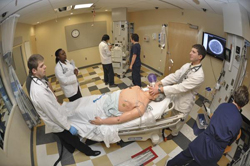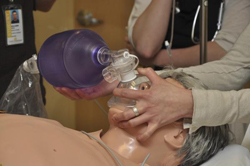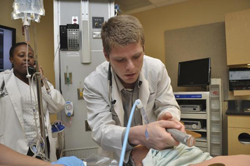 When students walk into a simulation room at Center for Advancing Professional Excellence, they know just about anything could
When students walk into a simulation room at Center for Advancing Professional Excellence, they know just about anything could
Simulation Educational Experiences
Interprofessional Education, School of Medicine
The scene in the room can be chaotic, mirroring a real medical situation as closely as possible. Medical and nursing students are expected to work as a team to diagnose and treat symptoms and to deal with the "patient's" family members or friends (the patient is a very expensive mannequin known as a "human patient simulator" with vital signs). It is a difficult assignment for
Things can get bumpy – lab tests are called
"Hey," shouts one nursing student waving an arm amid the clamor. Lab results just came in, and she can't get the team's attention.
This is why CAPE is an integral part of the interprofessional education effort at Anschutz Medical Campus. Students can learn their roles and how to communicate and work as a team before they get to an actual clinical setting.
Joey Failma, CAPE's senior simulation collaborator, who controls the "patient" from behind a two-way mirror, keeps the room lively. Often an actor, known as a standardized patient, plays the part of the patient's family member or friend. Managing and helping the loved one is an important role for the team.
 Afterward, the team debriefs with the standardized patient remaining in character to provide feedback to medical and nursing students.
Afterward, the team debriefs with the standardized patient remaining in character to provide feedback to medical and nursing students.
"I knew it was bad news but I didn't want to say that," one medical student told a standardized patient who was in the room with her "husband." "You don't want to give out bad news."
"But it would have been better if one of you had said it was really serious rather than the lack of answers," she countered.
In another simulation encounter with different students, it was the standardized patient playing the wife who mentioned that the patient's heart had flat-lined on a monitor. But a nursing student later said she had noticed it as well.
"I didn't know what to say," she said.
"Say what you see," Associate Professor of Surgery Thomas Whitehall, MD, insisted. "Families know what that means. They watch enough TV, and they know a flat line is not a good thing. "
One of the nursing students confessed that she felt it was "inappropriate" for the patient's wife to be in the room – an entrée for Whitehill, who was glad to discuss her discomfort, saying that family in the treatment room is becoming the norm in patient-centered care.
"It helps the family cope better, and it decreases lawsuits because they see all these well-intentioned people working hard to save someone," he said. If the family is rushed out of the room, "they start to fantasize about what's going on in there. For all they know, we're sitting around drinking coffee.
 "Patient family in the room is here to stay. It can be a struggle but it seems to give a better health outcome."
"Patient family in the room is here to stay. It can be a struggle but it seems to give a better health outcome."
The standardized patient in one of the scenarios backed him up.
"When my father died, I was thrown out of the room," he said. "I wasn't acting bad or disruptive, but they made me leave. Afterward, they came out of the room, and all they said was, 'Well, we did the best we could.' That was no consolation at all."
After a few more questions, the students thanked him, then started planning how to make the next encounter go a little more smoothly.